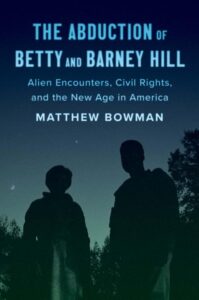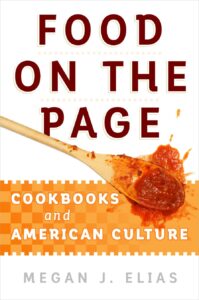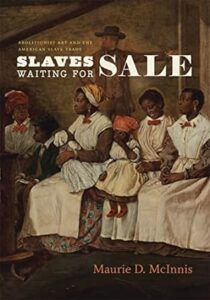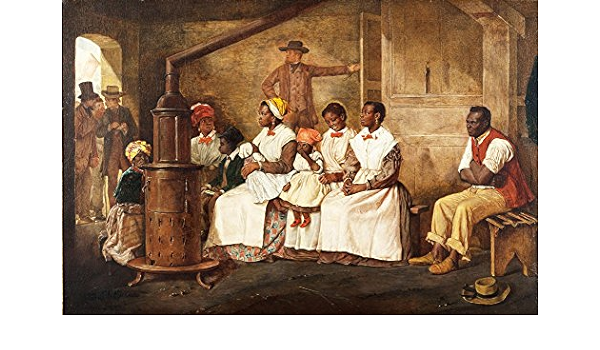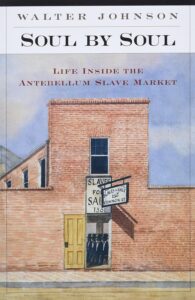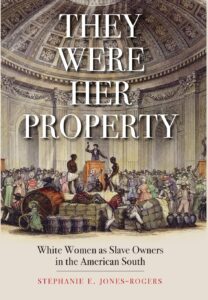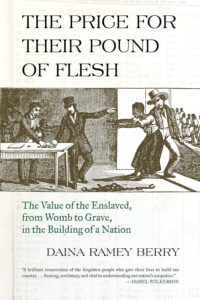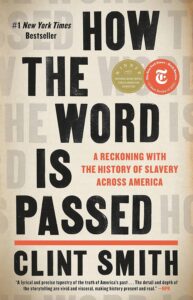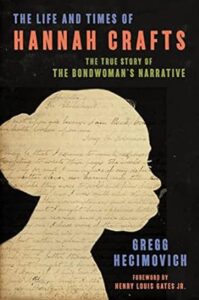 The Zoologist’s Guide to the Galaxy: What Animals on Earth Reveal About Aliens – and Ourselves. By Arik Kershenbaum. (Penguin Books, 2020. 356pp. Cloth, $24.99. Paper, $18.00.)
The Zoologist’s Guide to the Galaxy: What Animals on Earth Reveal About Aliens – and Ourselves. By Arik Kershenbaum. (Penguin Books, 2020. 356pp. Cloth, $24.99. Paper, $18.00.)
Imagining a place outside our own, a place in space, has gone hand in hand with imagining that beings other than ourselves might inhabit that place. Scientists agree that the laws of physics are universal (as far as we know). But what exobiologists, now called astrobiologists, have debated for decades is not only whether or not there is life somewhere else in the universe, but whether or not there are universal laws of biology that can apply to all life, so that we should know what to expect if we find that other life.
Most exobiologists in the 1960s and 1970s hedged their bets on the idea of whether or not there are universal laws of biology. After all, the only example we have of life is ourselves and the life on this planet. In The Zoologists Guide to the Galaxy, zoologist Arik Kershenbaum claims that there are universal laws of biology embedded in evolution and natural selection. All life, he argues, comes from natural selection, and therefore when considering extraterrestrial life, things like sociability and language would have developed among intelligent extraterrestrial species, indeed intelligence itself, would be common across all life, no matter where it originated. Extraterrestrials may evolve to fit in environments different than ours, but they would have the same objectives as humans and animals on earth do: the desire to survive and pass our genes onto the generations that come after. Only genes that promote this goal would be selected for and passed on.
To propagate an intelligent species, according to Kershenbaum, extraterrestrials must naturally select for not only physical but cultural traits to promote not just regeneration, but a desire to work together to build a better society and perhaps then seek out other lives among the stars. The biggest thread throughout Kershenbaum’s argument for universal laws of biology among intelligent species is the need to cooperate to achieve complicated goals.
I bought this book because it has good reviews on Amazon, and I was looking for a light read. What I ran smack into was a book that could have been transported from the works written in the 1960s and 1970s that I read for my dissertation discussing alien life: Carl Sagan, the Drake Equation, SETI. As mentioned, scientists with an interest in extraterrestrial life claimed and offered an ostensible reluctance to speculate about the nature of extraterrestrial life and generally agreed that the only way to determine if there are universal laws of biology would be to discover extraterrestrial life and study it, compare it to what we know. Writers like Sagan couldn’t help themselves though – they made many speculations about what extraterrestrial life might be like. And their arguments should draw just as much critical thought as Kershenbam’s do.
One conclusion exobiologists reached that is especially relevant to Kershenbaum’s thesis is their belief that life on earth evolved as a series of lucky accidents transmitted through the generations by natural selection. Rewind earth to the beginning and start all over, and genes naturally selected the second time around might develop into a completely different end state. Kershanbaum attempts to acknowledge this idea, but he is stubbornly wedded to his belief that nature will always naturally select for certain traits, especially in terms of intelligence. There are universal laws of biology.
It is okay to speculate on these things. The human mind is curious and likes to solve puzzles. Whether or not there is extraterrestrial life and how it will compare to life on earth has been debated for centuries. But we know so little even about life on own planet, that is seems a stretch to say we can determine universal laws of biology without finding other life. Until then, everything is mere speculation, and that speculation can be fun and interesting. But we can’t say with any certainty that it is anything other than speculation.
Perhaps I have read too many works by those who speculated about (extraterrestrial) life in the 1970s, but from where I sit we are facing the exact same problem, and we have just as few answers. Kershenbaum wants to break new ground, wants to share his ideas with a wider audience. But for all his lip service to acknowledging a certain variability in natural selection, he fails to convince me that his thesis holds weight. For him, all extraterrestrial life must evolve cooperation and sociability, all extraterrestrial life must evolve language, even if we can’t understand its form or content, all organisms with these traits will develop into cooperative societies and will come together to build culture and eventually take on projects like exploring the stars.
We just don’t know this to be true. There seems to be the assumption that cooperative alien societies would not destroy themselves a la the L variable in the Drake Equation. And because they have not destroyed themselves, perhaps they will have no interest in destroying us either. This ignores the many coercive systems on earth that have made large work projects possible that often involved the gross destruction of the environment and human life. This breakdown occurs often. Perhaps it is a universal law of biology.
Maybe I am not being fair. This book was not meant to be a scientific treatise. But there are so many holes in the argument it is hard to not pry it apart. I believe it is good to speculate, to imagine what could be here and elsewhere. But we need to take this book with a big grain of salt. It is okay to read it and enjoy it for fun. But taking the work as the last and most authoritative word on the subject is perhaps not the best way to approach this book. We must challenge it with our own knowledge and beliefs, our own hypotheses. That is science. That is what makes us human. That is what this all about.
Update 12/24/2023: In my original post I forgot to mention one thing that is prevalent among the exobiologists/astrobiologists that contemplate and pontificate on extraterrestrial life: many are credentialed scientists. Carl Sagan had a PhD from the University of Chicago and taught first at Harvard and then at Cornell. A lifelong participant in SETI, Sagan helped NASA design the records placed on the Pioneer and Voyager probes meant to communicate knowledge about earth and the human race through the medium of science, which they proposed would be driven by universal laws any intelligent extraterrestrials might be able to understand. Remember, they believed that laws of physics and mathematics were universal, and that even if extraterrestrials didn’t speak the same language as us, they would still be able to understand the more “objective” part of the message. Sagan and others used pulsars meant to help an extraterrestrial species help locate the origin of the records, earth.
Frank Drake received a PhD in astronomy from Harvard University. When not participating in attempts to find extraterrestrial life in the universe, particularly by participating in SETI, he became the Dean of Natural Science at the University of California at Santa Cruz. He also participated in developing the Pioneer and Voyager records. Many other participants in the search for extraterrestrial life have similar academic and professional credentials.
Arik Kershenbaum’s biography is the first thing you see when you open his book, and the first knowledge about the author revealed in this biography is that he is a “zoologist, college lecturer, and fellow at Girton College, University of Cambridge.” Further, “He is a member of the international board of advisors of METI.org, a think tank on the topic of messaging extraterrestrial intelligence.”
Why is this important? All these scientists, including someone has famous as Sagan, hid behind their academic and professional credentials when speculating as to the nature of extraterrestrial life. But there were others from outside science postulating their own theories about intelligent life in the universe. Erik von Daniken, famous for popularizing the idea of what has become known as visits from “ancient astronauts” or “ancient aliens” did not have this shield to hide behind, he was a layman, he did not use the scientific method, and therefore his ideas had no weight in the scientific community. But his enduring popularity demonstrates that not everyone needed “legitimate” credentials to win over a loyal audience. Von Daniken portrayed himself as an archeologist, a historian of the ancient world, and attracted millions of interested readers and spawned movies and television shows you can watch to this day. And von Daniken achieved this fame by claiming to be a scientist, even though there are many, many flaws in his investigations and the presentation of his conclusions. This attempt to use science both hard and soft to legitimate his ideas just further demonstrates how important these credentials were to winning over a credulous audience. He portrayed a layman who could take on big science. He was accessible.
This popularity flew in the face of what scientists like Sagan were trying to do. They hoped to postulate on extraterrestrial life from a position based in science, a position that belied any doubts or criticism. Believe me because I have these degrees, because I have had these experience, and these things are what make me legitimate, these things are what make my theories worth believing. Even if I have just as little knowledge about extraterrestrial life that you have because at this point it is a universal unknown. My powers of deduction are superior to yours because I have an advanced degree, because I have spent my professional life working on this puzzle with other similarly credentialed parties.
The Drake Equation is a classic example of scientists trying to deduce whether or not there is life elsewhere in the universe using what appeared to be the scientific method. It consists of a series of variables meant to help estimate how many intelligent, communicating extraterrestrials there are in the universe. From Wikipedia, that Drake Equation is:
where
- N = the number of civilizations in the Milky Way galaxy with which communication might be possible (i.e. which are on the current past light cone);
and
- R∗ = the average rate of star formation in our Galaxy.
- fp = the fraction of those stars that have planets.
- ne = the average number of planets that can potentially support life per star that has planets.
- fl = the fraction of planets that could support life that actually develop life at some point.
- fi = the fraction of planets with life that actually go on to develop intelligent life (civilizations).
- fc = the fraction of civilizations that develop a technology that releases detectable signs of their existence into space.
- L = the length of time for which such civilizations release detectable signals into space.
As the equation progresses, each variable becomes more and more speculative. Fifty odd years later, we have barely started to gain the ability to determine the third variable, ne, even though an argument could easily be made that we have barely made progress on the first variable, R*. That is one thing the Webb telescope is aiming to do, and in the short time it has been observing the universe it has already challenged our understanding of the way the universe, specifically galaxies, are formed.
Yet Drake and others believed they could still guesstimate at the correct number for each variable and select for the presence or absence of extraterrestrial intelligent life. What better way to legitimate your search mathematically and scientifically than to break down the problem into a mathematical equation? This equation might have been incomprehensible to a lay audience, but that was part of the game. Science can often gain legitimacy by being opaque. Scientists are the only ones who understand this concept, therefore they are the only ones who can explain it to me. This speculative equation holds weight because the experts say it does. Their prestige means they are trustworthy and objective and therefore their conclusions are valuable and impregnable. Scientists are reliable narrators who should be venerated for explaining complex concepts in ways I can understand.
Drake and others did admit that the equation came to be increasingly speculative, but that didn’t stop them from using it to calculate the odds there might be intelligent life somewhere out there, given they didn’t (or we didn’t) destroy themselves first.
This brings me back to Kershenbaum. He is just part of a long history of speculators using scientific and academic credentials to provide legitimacy to his entirely speculative theories on what life would be like on other planets. It will be like life on earth, he says implicitly and explicitly, even though it might have some qualities we might not expect or might struggle to recognize. Life and biology have universal qualities that we can extract from the only example we have. But I, Kershenbaum, have these qualifications that make me legitimate, that means my speculations hold objective weight. I am just following the bread crumbs.
It may not seem fair to pigeonhole these writers. And besides, as I said, this speculation and curiosity are what make us human. But we must also be vigilant of the sources we receive our information from, no matter their credentials and charisma. We must understand when the authors are engaged in speculation. We must challenge their conclusions, no matter how many degrees they have. Sagan, Drake, and their colleagues might be closer to von Daniken than they are willing to admit. Thought experiments are good, they grow our brains, but at the end of the day we still need to be honest about our goals, our assumed meanings, and leave open the door for new information and new surprises.
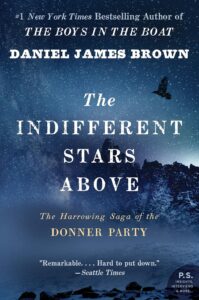 The Indifferent Stars Above: The Harrowing Saga of the Donner Party. By Daniel James Brown. (Boston: Mainer Books, 2009. pp. 384. Paper, $18.99.)
The Indifferent Stars Above: The Harrowing Saga of the Donner Party. By Daniel James Brown. (Boston: Mainer Books, 2009. pp. 384. Paper, $18.99.)